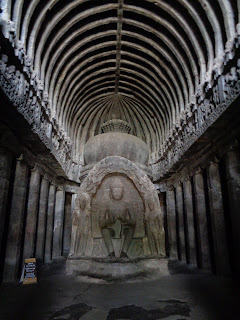5/9/14 Mumbai Day 2
Today began with a visit to the US Consulate in Mumbai. We heard from a foreign service officer and a
public affairs project manager they spoke about a variety of topics including
manufacturing, agriculture, and terrorism in India. One interesting factoid: 50% of India’s population
works in agriculture, but this industry only accounts for 14% of the country’s
GDP; residents usually spend between 40% and 60% of their income on food. India is working to make agriculture more
efficient and to lower food prices for the population, but this poses other
problems. For instance, if much of the
workforce leaves agriculture, millions of new jobs must be created for them in
other sectors.
Lunch was again amazing.
Every time I have Indian food in the states, I eat until I can’t eat
another bite; I have continued this trend so far in India. I am loving every bite and so far it is
sitting well in my stomach.
We had a long afternoon academic session today, an
Introduction to Climate Change Science. This
class was a long lecture, but there is a plan to organize more discussion and
group work into the class sessions to break up the lectures. Tomorrow another class in the afternoon.
After class, we played cricket (hit batting practice) in the
street with lots of kids a couple blocks from our hotel. The makeshift “wicket” was a piece of wood
propped up by a smaller piece of wood. Batting
the ball is more like golfing than hitting a baseball, but the technique is
much different. Bowling (pitching) was
easier to get the hang of than batting.
Before each pitch a lane was cleared between the pitcher and the
batter. Immediately after the ball was
hit, 6 or 7 kids would start running after the ball; if you get the ball, you
get to bowl. Despite their all-out efforts
to track down the hits, the kids were very generous with giving us (the
Americans) the balls so we could try bowling.
They were also willing to give the ball to their friends. Runnign after the ball was more about the
chase than the opportunity to bowl next.
With many tennis balls in the rotation, the result was a constant stream
of new bowlers among kids alternately running after the hits and watching the
batter intently to see where the next ball would go. Professor Ganguly, traveling with the group
from Northeastern and teaching the Climate Change classes, was right in front
for the fielding. Each time he caught a
line drive, he turned around with a giant smile across his face.
Another excellent meal followed the cricket game. Tomorrow we visit the Dharavi slum. It is the largest slum in the world, housing
over 1 million people. I am looking
forward to seeing how it compares to the Mathare slum I visited in Kenya in
2007. Pictures next time (probably).



Comments
Post a Comment